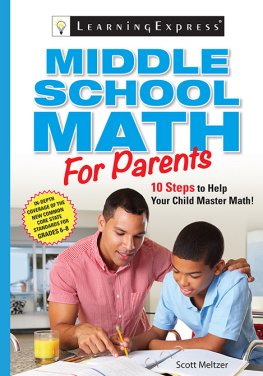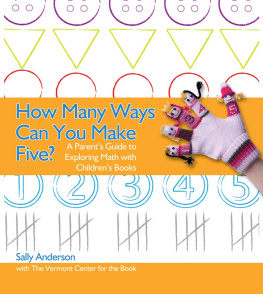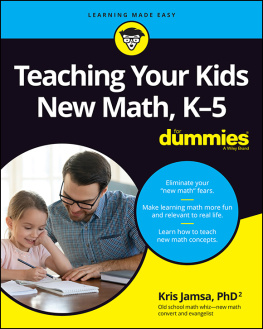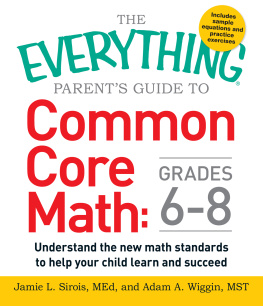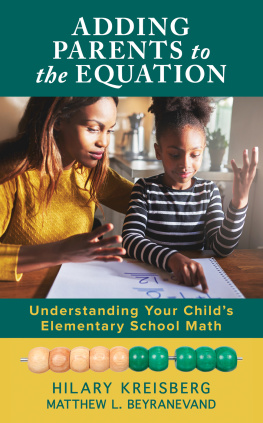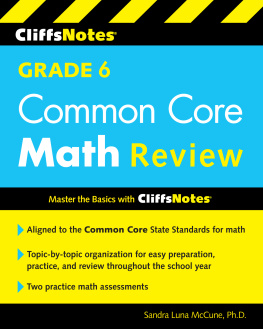About the Author
Scott Meltzer is a National Board-certified early adolescence math teacher with 12 years of experience in education, both as a teacher and a coach (providing professional development and support for teachers). He has worked at all levels, elementary through college, in a variety of schoolspublic, alternative, and charter schoolsin New York City, Seattle, and Philadelphia. His passion is working with inner-city students because he believes that all children can be great mathematicians and deserve a great education.
Meltzer lives in Philadelphia with his wife, Dr. Rachel Fleishman, and their two sons, Jacob and Benjamin. He dreams of writing the Great American Novel when he grows up.
Contents
Chapter 1 Attitude Is Everything: Dealing with Maths Positives and Negatives
Why Your Childs Attitude Matters
Why Your Attitude Matters
Absolute Value: Turning a Negative into a Positive
Integer Addition: Take Control of Math Attitude
Integer Subtraction: Dont Do It!
Multiplication with Signed Numbers
Using Fact Families for Multiplication and Division
Summary
Chapter 2 Fractionphobia: Facing the (Totally Rational) Fear of Rational Numbers
The First Day of Middle School
The Origin of Mathphobia
A Gentle Approach to Fractions
Unit Fractions
Non-Unit Fractions and Mixed Numbers
Equivalent Fractions
Adding and Subtracting Like Fractions
Adding and Subtracting Unlike Fractions
Multiplying a Fraction and a Whole Number
Multiplying Fractions Together
Dividing with Unit Fractions
Dividing with Any Fractions
Summary
Chapter 3 Mental Math Rules!: Unlocking the Secrets of the Base-Ten System and Understanding Decimals
Why Mental Math Matters
What Is the Base-Ten System?
Adding and Subtracting in Base-Ten
Multiplying in Base-Ten
Dividing in Base-Ten
Long Division
Summary So Far
Decimals
Converting Fractions to Decimals
Operating with Decimals
Summary
Chapter 4 Learning the New Way: Why Ratios and Proportions Make More Sense Now Than Ever
Math Hasnt Changed
Following a Recipe vs. a Chefs Craft
Proportions (and the Problem with a Procedural Approach)
Understanding Ratios
Method #1: Ratio Tables
Method #2: Equivalent Fractions
Method #3: Unit Rates
Method #4: Proportional Equations
Which Method, and When?
Percentages: A Special and Very Common Use of Proportions
Summary
Chapter 5 Visualize Everything: How Simple Geometry Concepts Can Make Numbers, Operations, and Algebra Easier
The Power of Visualization
The Three Dimensions
Length and Area
Finding the Area of a Polygon
Using Area as a Visual Tool
Area of a Triangle
Area of Other Polygons
Three-Dimensional Measures
Scale Drawings and Similarity
Similar Figures
Visualizing Word Problems
Summary
Chapter 6 The Joy of Geometry: Having Fun with Math and Why Fun Matters
The Importance of Having Fun
Angle Relationships
The Pythagorean Theorem
Solving Problems with the Pythagorean Theorem
Transformations
Measuring Circles
Summary
Chapter 7 The Two Most Important Words in Mathematics: How Why and Because Can Unlock the Language of Algebra
The Right Parent
Introduction to Algebra
The Basics of Algebraic Language
Writing Expressions from Words
Order of Operations (and the Problem with Dear Aunt Sally)
Equivalent Expressions
Writing Algebraic Equations
Summary
Chapter 8 The Many Meanings of I Dont Know: Learning to Turn Unknowns into Knowns
Three Dreaded Words
The Good Meanings
The Not-So-Good Meanings
Solutions to Equations
Solving One-Step Equations
Solving Proportions
Solving Two-Step Equations
Simplifying Equations
Summary
Chapter 9 Math Is Life: Linear Relationships in Everyday Life and Why They Matter
Linear Relationships in Life
Proportions: The Simplest Linear Relationships
Coordinate Graphs
Multiple Representations
Linear Relationships
Linear Relationships in Other Representations
y = mx + b
Summary
Chapter 10 Life Is Math: How to Make Sense of Data and Statistics All Around You
Data and Statistics Are Everywhere!
What Are Data and Statistics?
Displaying Data
Reading and Comparing Data Displays
Measures of Center
Measures of Variability
Comparing Data Sets
Sampling from Populations
Summary
Final Thoughts
Acknowledgments
Copyright 2014 LearningExpress, LLC.
All rights reserved under International and Pan American Copyright Conventions.
Published in the United States by LearningExpress, LLC, New York.
Cataloging-in-Publication Data is on file with the Library of Congress.
Printed in the United States of America
9 8 7 6 5 4 3 2 1
ISBN 978-1-57685-944-5
For more information on LearningExpress, other LearningExpress products, or bulk sales, please write to us at:
80 Broad Street
4th Floor
New York, NY 10004
Or visit us at:
www.learningexpressllc.com
Introduction
Raise your hand if your parent has ever tried to help you with math, and it ended in tears.
I have often posed this question to my eighth-grade students, with startling results. Even at that most self-conscious age, when everybody is afraid to be teased and emotion and self-doubt are taboo, a majority of students raise their hands.
I imagine a familiar drama playing out in many forms in many homes far too often. The roles may be different, but the core issue is the same.
The child is working on math homework at the kitchen table while Mom prepares supper.
Mom, whats two-thirds divided by one-sixth?
You know Im not a math person. Youll have to ask your father when he gets home .
When Dad walks in, the child approaches him with the homework.
Dad, can you help me with this?
Sure, lets take a look .
But as Dad flips through the pages of the textbook, he finds himself disappointed and frustrated. The examples he was hoping for are not therein fact, there dont seem to be very many numbers at all, for a math book. Its all words and pictures. Math isnt what it used to be. What was wrong with the old way?
Dad comes up with what seems to him like a reasonable solution: Let me show you the way I remember doing it.
Dad works through some of the homework problems for himself. But the answers dont seem right, and when he types them into the calculator it keeps giving him these weird decimals. However, certain he has remembered the method correctly, he forges ahead and shows the child how to do it his way.
As the child tries to follow Dads example, things dont work out. The child is doing it all wrong, and Dad is losing patience. Infuriated by the childs apparent refusal to understand, Dads words and tone become less and less kind, until the child feels he is being outright aggressive. The child cannot take another second of Dads impatience, harsh feedback, and inability to explain. Mom tries to stay out of it, but soon sparks fly. Once again, math has started a war.
If this scenario sounds familiar to you, you are not alone. The math war rages nightly in homes everywhere. Parents want to help and they try so hard, with the best of intentions. But it never seems to work. Some parents, like the mother in our little drama, believe that the best thing is to stay out of it. Others, like the father, want so badly to be helpful, but things always seem to go south.
The father in our example is aware of a generation gap that exists between todays students and their parents, with respect to the math classroom. Math education has changed in the last 10 to 20 years, leaving many parents more confused than ever.
Next page
